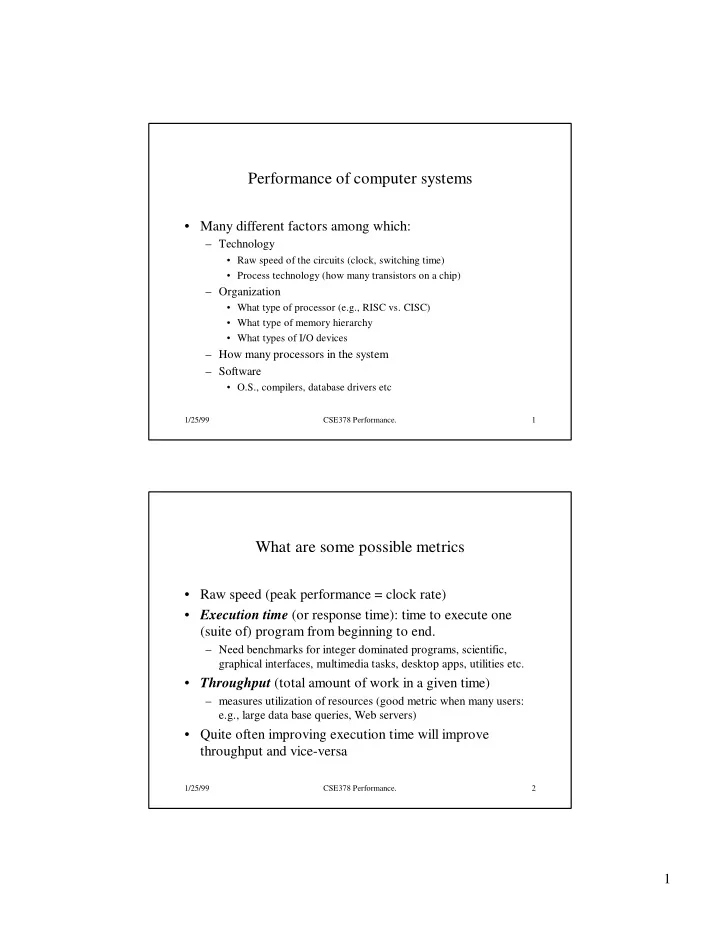

Performance of computer systems • Many different factors among which: – Technology • Raw speed of the circuits (clock, switching time) • Process technology (how many transistors on a chip) – Organization • What type of processor (e.g., RISC vs. CISC) • What type of memory hierarchy • What types of I/O devices – How many processors in the system – Software • O.S., compilers, database drivers etc 1/25/99 CSE378 Performance. 1 What are some possible metrics • Raw speed (peak performance = clock rate) • Execution time (or response time): time to execute one (suite of) program from beginning to end. – Need benchmarks for integer dominated programs, scientific, graphical interfaces, multimedia tasks, desktop apps, utilities etc. • Throughput (total amount of work in a given time) – measures utilization of resources (good metric when many users: e.g., large data base queries, Web servers) • Quite often improving execution time will improve throughput and vice-versa 1/25/99 CSE378 Performance. 2 1
Execution time Metric • Execution time: inverse of performance Performance A = 1 / (Execution_time A ) • Processor A is faster than Processor B Execution_time A < Execution_time B Performance A > Performance B • Relative performance Performance A / Performance B =Execution_time B / Execution_time A 1/25/99 CSE378 Performance. 3 Measuring execution time • Wall clock, response time, elapsed time • Some systems have a “time” function – Unix 13.7u 23.6s 18:37 3% 2069+1821k 13+24io 62pf+0w • Difficult to make comparisons from one system to another • Remainder of this lecture: CPU execution time 1/25/99 CSE378 Performance. 4 2
Definition of CPU execution time CPU execution_time = CPU clock_cycles*clock cycle_time • CPU clock_cycles is program dependent thus CPU execution_time is program dependent • clock cycle_time ( nanoseconds , ns) depends on the particular processor • clock cycle_time = 1/ clock cycle_rate (rate in MHz ) – clock cycle_time = 1 µ s, clock cycle_rate = 1 MHz – clock cycle_time = 1ns, clock cycle_rate = 1 GHz • Alternate definition CPU execution_time = CPU clock_cycles / clock cycle_rate 1/25/99 CSE378 Performance. 5 CPI -- Cycles per instruction • Definition: CPI average number of clock cycles per instr. CPU clock_cycles = Number of instr. * CPI CPU exec_time = Number of instr. * CPI * clock cycle_time • Computer architects try to minimize CPI • CPI in isolation is not a measure of performance – program dependent, compiler dependent • In an ideal pipelined processor (to be seen soon) CPI =1 – but… not ideal so CPI > 1 – could have CPI <1 if several instructions execute in parallel (superscalar processors) 1/25/99 CSE378 Performance. 6 3
Classes of instructions • Some classes of instr. take longer to execute than others – e.g., floating-point operations take longer than integer operations • Assign CPI’s per classes of inst., say CPI i CPU exec_time = Σ (CPI i * C i )* clock cycle_time where C i is the number of insts. of class i that have been executed • Note that minimizing the number of instructions does not necessarily improve execution time • Improving one part of the architecture can improve the CPI of one class of instructions – One often talks about the contribution to the CPI of a class of instructions 1/25/99 CSE378 Performance. 7 How to measure the average CPI A given of the Elapsed time: wall clock processor CPU exec_time = Number of instr. * CPI * clock cycle_time • Count instructions executed in each class • Needs a simulator – interprets every instruction and counts their number • or a profiler – discover the most often used parts of the program and instruments only those – or use sampling • Use of programmable hardware counters – most modern microprocessors have this feature 1/25/99 CSE378 Performance. 8 4
Other popular performance measures: MIPS • MIPS (Millions of instructions per second) MIPS = Instruction count / (Exec.time * 10 6 ) MIPS = (Instr. count * clock rate)/(Instr. count *CPI * 10 6 ) MIPS = clock rate /(CPI * 10 6 ) • MIPS is a rate: the higher the better • MIPS in isolation no better than CPI in isolation – Program and/or compiler dependent – Does not take the instruction set into account – can give “wrong” comparative results 1/25/99 CSE378 Performance. 9 Other metric: MFLOPS • Similar to MIPS in spirit • Used for scientific programs/machines • MFLOPS: million of floating-point ops/second 1/25/99 CSE378 Performance. 10 5
Benchmarks • Benchmark: workload representative of what a system will be used for • Industry benchmarks – SPECint and SPECfp industry benchmarks updated every 3 years – Perfect Club, NASA kernel: scientific benchmarks – TPC-A, TPC-B, TPC-C and TPC-D used for databases and data mining – Benchmarks for desktop applications, web applications are not as standard – Beware! • Compilers are super optimized for the benchmarks 1/25/99 CSE378 Performance. 11 How to report (benchmark) performance • If you measure execution times use arithmetic mean – e.g., for n benchmarks ( Σ exec_time i ) / n • If you measure rates use harmonic mean n/ ( Σ 1 / rate i ) = 1/(arithmetic mean) 1/25/99 CSE378 Performance. 12 6
Recommend
More recommend